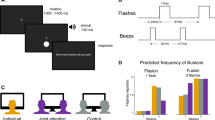Abstract
When a single brief flash is accompanied by two auditory beeps, participants often report perceiving two flashes. The present experiment examined whether the perception of illusory redundant flashes can result in faster responses as compared to the perception of a single flash, because previous research has shown such a redundancy gain for physical stimuli. To this end, participants were asked to respond as rapidly as possible to the onset of any flash. Following their response, they additionally indicated whether they perceived a single flash or a double flash. Most importantly, we observed significant shorter reaction times in response to redundant flashes, irrespective of whether they were physically presented or illusorily perceived. Taken together, our results suggest that an illusory percept can affect simple reaction time in much the same manner as the corresponding physical stimulation.


Similar content being viewed by others
Notes
In order to test the stability of the observed effects we carried out two re-analyses of the data applying different exclusion criterion values. In the first re-analysis, we lowered the criterion number of valid trials per condition from 40 to 30. As a result we were able to include the data of two additional participants (n = 28). Most importantly, the results of the ANOVA were not altered by including the data of these participants. The main effect of stimulation was still significant, F(1,27) = 78.54, MSE = 736.94, P < .05, as was the main effect of redundancy, F(1,27) = 4.71, MSE = 267.75, P < .05. The interaction between redundancy and stimulation was again far from statistical significance, F < 1. In the second re-analysis, we increased the criterion number of valid trials per condition from 40 to 50. Consequently, we had to exclude the data of four participants (n = 22). However, the pattern of ANOVA results was still not altered. The main effect of stimulation still was significant, F(1,21) = 46.82, MSE = 882.63, P < .05, as was the main effect of redundancy, F(1,21) = 5.21, MSE = 281.25, P < .05. Furthermore, the interaction between redundancy and stimulation was again not significant, F < 1.
References
Berger TD, Martelli M, Pelli DG (2003) Flicker flutter: is an illusory event as good as the real thing? J Vis 3:406–412
Biederman I, Checkosky SF (1970) Processing redundant information. J Exp Psychol 83:486–490
Corballis MC (2002) Hemispheric interactions in simple reaction time. Neuropsychologia 40:423–434
Cousineau D (2005) Confidence intervals in within-subject designs: a simpler solution to Loftus and Masson’s method. Tutor Quant Method Psychol 1:42–45
Fiedler A, Schröter H, Seibold VC, Ulrich R (2011) The influence of dichotical fusion on the redundant signals effect, localization performance, and the mismatch negativity. Cogn Affect Behav Neurosci 11:68–84
Giray M, Ulrich R (1993) Motor coactivation revealed by response force in divided and focused attention. J Exp Psychol Hum Percept Perform 19:1278–1291
McCormick D, Mamassian P (2008) What does the illusory-flash look like? Vis Res 48:63–69
McGurk H, MacDonald J (1976) Hearing lips and seeing voices. Nature 264:746–748
Miller JO (1982) Divided attention: evidence for coactivation with redundant signals. Cogn Psychol 14:247–279
Miller J, Franz V, Ulrich R (1999) Effects of auditory stimulus intensity on response force in simple, go/no-go, and choice RT tasks. Percept Psychophys 61:107–119
Miller J, Beutinger D, Ulrich R (2009) Visuospatial attention and redundancy gain. Psychol Res 73:254–262
Mishra J, Martinez A, Sejnowski TJ, Hillyard SA (2007) Early cross-modal interactions in auditory and visual cortex underlie a sound-induced visual illusion. J Neurosci 7:4120–4131
Mishra J, Martinez A, Hillyard SA (2009) Effect of attention on early cortical processes associated with the sound-induced extra flash illusion. J Cogn Neurosci 22:1714–1729
Mordkoff JT, Yantis S (1991) An interactive race model of divided attention. J Exp Psychol Hum Percept Perform 17:520–538
Mordkoff JT, Yantis S (1993) Dividing attention between color and shape: evidence of coactivation. Percept Psychophys 53:357–366
Rosenthal O, Shimojo S, Shams L (2009) Sound-induced flash illusion is resistant to feedback training. Brain Topogr 21:185–192
Schröter H, Ulrich R, Miller JO (2007) Effects of redundant auditory stimuli on reaction time. Psychonomic Bull Rev 14:39–44
Schröter H, Frei LS, Ulrich R, Miller JO (2009) The auditory redundant signals effect: an influence of number of stimuli or number of percepts? Atten Percept Psychophys 71:1375–1384
Shams L, Kamitani Y, Shimojo S (2000) What you see is what you hear. Nature 408:788
Shams L, Kamitani Y, Shimojo S (2002) Visual illusion induced by sound. Cogn Brain Res 14:147–152
Shams L, Ma WJ, Beierholm U (2005) Sound-induced flash illusion as an optimal percept. Neuroreport 16:1923–1927
Sperandio I, Savazzi S, Marzi CA (2010) Is simple reaction time affected by visual illusions? Exp Brain Res 201:345–350
Stahl J, Rammsayer TH (2005) Accessory stimulation in the time course of visuomotor information processing: stimulus intensity effects on reaction time and response force. Acta Psychol 120:1–18
Watkins S, Shams L, Tanaka S, Haynes J-D, Rees G (2006) Sound alters activity in human V1 association with illusory visual perception. Neuroimage 21:1247–1256
Watkins S, Shams L, Josephs O, Rees G (2007) Activity in human V1 follows multisensory perception. Neuroimage 37:572–578
Acknowledgments
This study was supported by the Deutsche Forschungsgemeinschaft (SCHR1180/2-2). We thank Nicola Bruno and an anonymous reviewer for helpful and constructive comments on an earlier version of this manuscript.
Author information
Authors and Affiliations
Corresponding author
Rights and permissions
About this article
Cite this article
Fiedler, A., O’Sullivan, J.L., Schröter, H. et al. Illusory double flashes can speed up responses like physical ones: evidence from the sound-induced flash illusion. Exp Brain Res 214, 113–119 (2011). https://doi.org/10.1007/s00221-011-2811-z
Received:
Accepted:
Published:
Issue Date:
DOI: https://doi.org/10.1007/s00221-011-2811-z




